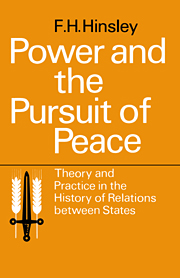Book contents
- Frontmatter
- Contents
- INTRODUCTION
- PART I A HISTORY OF INTERNATIONALIST THEORIES
- PART II A HISTORY OF THE MODERN STATES' SYSTEM TO 1900
- 8 The Beginnings of the System
- 9 The First Fifty Years
- 10 The Concert of Europe
- 11 International Relations in the Second Half of the Nineteenth Century
- PART III INTERNATIONAL RELATIONS AND INTERNATIONAL ORGANIZATIONS IN THE TWENTIETH CENTURY
- References
- Index
11 - International Relations in the Second Half of the Nineteenth Century
Published online by Cambridge University Press: 11 January 2010
- Frontmatter
- Contents
- INTRODUCTION
- PART I A HISTORY OF INTERNATIONALIST THEORIES
- PART II A HISTORY OF THE MODERN STATES' SYSTEM TO 1900
- 8 The Beginnings of the System
- 9 The First Fifty Years
- 10 The Concert of Europe
- 11 International Relations in the Second Half of the Nineteenth Century
- PART III INTERNATIONAL RELATIONS AND INTERNATIONAL ORGANIZATIONS IN THE TWENTIETH CENTURY
- References
- Index
Summary
There was a marked contrast between the opening years of this period and the years between 1815 and 1854. After forty years of almost unbroken peace the fourteen years from the end of the Crimean War to 1870 witnessed four more wars involving one or more of the major Powers. In the course of these wars―the Austro-French War in Italy of 1859, the German war with Denmark of 1864, the Austro-Prussian War of 1866, the Franco-Prussian War of 1870–1―the territorial arrangements of 1815 were forcibly revised and the settlement of 1856 did not come through unscathed.
As well as embarking on this succession of wars the European states returned, for the first time since the eighteenth century, to policies and objectives reminiscent of the ancien régime. Since 1815 agreements between the Powers had with rare exceptions been either universal agreements, the outcome of conferences and amounting almost to international legislation, or―if not universal―imprecise and temporary associations, understandings rather than alliances. In the same period changes and revisions of territory had received the sanction, and often the guarantee, of all the Great Powers. There was now a return to precise and offensive military alliances, whose primary purpose was to secure the neutrality or the assistance of another Power in a projected war; and demands for unilateral territorial exchanges in return for this assistance, or in compensation for the gains which other Powers had derived from these wars, became the order of the day.
- Type
- Chapter
- Information
- Power and the Pursuit of Peace: Theory and Practice in the History of Relations Between States , pp. 238 - 272Publisher: Cambridge University PressPrint publication year: 1962



